Steve Kim—Creator of KimKim Sauce (the Most Flavorful and Fiery Stocking Stuffer)

Forget about candy canes. Try KimKim Sauce. It’s the perfect stocking stuffer. The colors are right—from the rich deep red color of the sauce itself to the splash of green color on the label that sets off Korean characters—and the price is right. At at suggested retail price of $6.99 a bottle, you can spice up a loved one’s or work colleague’s life with an affordable gift that keeps giving. (Sixteen fluid ounces of moderate heat packaged in an easy-to-use squeeze bottle will brighten many many meals.)
I didn’t come up with this gifting idea on my own. I heard it first-hand from the inventor of KimKim Sauce, Steve Kim, who, during a phone interview, told me how KimKim Sauce got its start. Prudently, Kim sought to get his trial production run as small as possible. He began with a small batch of 150 cases of the sauce requiring an outlay of a few thousand dollars. To limit risk, Kim had done market research before committing to the initial run; yet, even after doing diligent research, it can be difficult to anticipate exactly how well a product will be received in the marketplace. If the sauce didn’t do well, Kim recalled, in worst case scenario, they would have had several cases of the sauce to use as Christmas gifts. The color is perfect!, he added.
The sauce did do well, however, and, in fact, so well that Kim is currently developing a Korean barbecue marinade, which he plans to have ready for next summer. Eventually, he hopes to have a whole line of Asian sauces and condiments.
During our Q & A, split between two telephone calls spread more than a year apart, Kim shared his advice for launching a food product, the story of how KimKim Sauce came to be, what his favorite food is to douse with KimKim Sauce, and more. Right off the bat, during that first call, it was clear that Steve Kim is a nice guy—generous, easy-going, and kindhearted—and is truly passionate about food and eating.
When I rang him, I caught him just after he’d finished eating a lunchtime meal at the restaurant Stone Soup in Burlington, Vermont. High off of that experience, he gushed about the sandwich he’d just eaten, made with house made chopped chicken liver with crispy chicken skin mixed in served on homemade wheat bread. Then we launched into our discussion of KimKim Sauce.
Jennings: What goes into the process of making an award-winning sauce?
Kim: I’ll be philosophical first, and then I’ll talk about the actual process.
Philosophically, it’s about making stuff that I want to eat. KimKim Sauce is something that I love to eat, that I enjoy putting on my food, that I share with my friends. It wasn’t really about doing something to market to a certain customer segment or thinking about strategy. It was just basically answering the question “What do I love to eat?” So then, from that point it’s a lot easier when it’s all about your own personal taste and what you believe in and are passionate about. Certainly it’s a good place to start.
Then there’s the process of developing a specific product.
There are a lot of different ways to get flavor out of ingredients but for me, one of the ways to get great flavor is the through the process of fermentation or aging. Fermentation is a really great great way to enhance flavor and to get that umami profile.
That’s where the traditional Korean gochujang comes in. It’s the key ingredient of what we do.
You’re taking sun-dried red peppers and combing it with rice and some other natural ingredients like malt and barley. You let it sit for months at a time. When you let it sit on the shelf for months, lots of cool, interesting things happen to that product. It ferments and ages and develops funky flavors that come into play. That’s gochujang. We take that and round it out with some apple cider vinegar to add a touch of a vinegary element, a little bit of sweet, and a little bit of soy for nuttiness.
Jennings: So it’s the gochujang that’s contributing the deep, resonate, rich, fermented, complex flavors?
Kim: Oh yeah, gochujaneg is the core of KimKim Sauce. Everything else just rounds it out. The fermentation is the core of that unique funk. When people first try KimKim Sauce, they kind of have a puzzled look on their face. They’re looking for the typical pure hot or maybe the vinegary taste that you get with most hot sauces, which also tend to be thin. But with our sauce, you get a naturally thick sauce and natural fermented flavor.
Jennings: So you’re saying that the thickness of your sauce is one of the things that gochujang provides?
Kim: Yes, it does. The gochujaneg is naturally very thick—like a paste.
Jennings: And then you’re watering it down, not in flavor, but in consistency, with the other ingredients that you add to it?
Kim: Yeah, it would barely be able to come out of the bottle, it would be so thick. Plus you want some of the vinegary tartness, and the vinegar helps to loosen it up a bit so that it becomes more of a sauce instead of a paste.
Jennings: How did you decide the chile heat level of the sauce?
Kim: So, I love spicy food. I go to a restaurant and I’ll order the Thai hot or number 5 or whatever the highest number is and I’ll be sweating and everything, but that’s more for me. I wanted a sauce that people could use all the time. So, I didn’t want to go extreme in terms of hot. It’s on our kitchen table all the time. You can put it on everything from macaroni and cheese to pizza, chicken, whatever.
Our slogan or what we stand for is the idea that fire and flavor are finally friends. KimKim Sauce a really good balance of great flavor with some heat. You don’t get the heat right away. The heat kind of comes in at the end. So people of all ages love it. We wanted to be able to appeal to lots of people. That’s not to say that in the future we won’t have another sauce that will be really hot, for the crazy hot sauce lovers.
Jennings: How does its heat level compare to what you would find in Korea?
Kim: I’d say relative to typical Korean foods, it’s middle to lower in terms of the heat index. Compared to other hot sauces like Tabasco, Sriracha, or Cholula—and these are all sauces I love to use on my foods—I’d say it’s a tad below those.
Jennings: Is there anything special about the Korean hot peppers that contributes to the flavor?
Kim: It is a traditional Korean red pepper, which is sun-dried. The pepper is grown and cultivated and sun-dried in Korea. I like to use them to keep some of the traditional roots behind the sauce. To keep the sauce, authentically Korean, all the heat in the sauce comes from the Korean sun-dried peppers that are in the gochujang.
Jennings: When you were testing did you end up going down any wrong paths?
Kim: Because this is the stuff that I grew up on, there wasn’t a massive amount of experimentation. It was really a matter of getting the viscosity right—is it too loose, it is too thick? And the balance of flavors—how to thin it and get the flavor right. That was where the testing and experimentation was.
Jennings: How did the sauce get its start?
Kim: My mom cooks Korean food all the time. When you do a lot of grilled meats, and fish, and chicken, you have this condiment on hand to dip foods into or to put on top of the grilled meats. I used to make it all the time but it was always the thick form of it. And it got tiring to keep making these small little bowls of it that I sometimes wouldn’t get to; they’d get dried out in the fridge and some of it would get wasted. I thought, hey, I like using it, and rather than see it dry out in the refrigerator why not loosen it up a little and put it in a plastic bottle. And that’s how it got started.
Jennings: How wonderful to use a key flavor that you grew up with and have so much association with.
Kim: This is a very familiar flavor. If you’re Korean and you grew up eating Korean food, you’ll know exactly what this is. But the cool thing about KimKim Sauce, because it’s readily available and it’s in this form, you can put on lots of different things.
If I were in collage, this would be my go-to meal: I would take ramen, cook it in the microwave and douse it with KimKim Sauce. It would be nice if you had some toasted sesame seeds, too, but, you know, you’re in collage. Today I’d add some cucumbers and leftover grilled meat and things like that. But if you’re tired of the typical Top Ramen in your dorm room, adding KimKim Sauce could be a great way to do a different style of the ramen noodle.
Jennings: What are the most unusual ways you’ve heard of people using KimKim Sauce?
Kim: There’s this guy who loves it. He works in one of the retail stores where we sell it; actually it’s one of the first places where we sold it—Belmont Butchery. He literally puts it on everything. One day he told me that he put it on brownies. That’s a little too far fetched. I haven’t tried it personally. That’s probably the strangest.
Jennings: What’s your favorite way to eat it?
Kim: My all-time favorite way to using it is on mac-n-cheese—either just boxed Kraft Macaroni & Cheese or homemade penne pasta mac and cheese with Gruyère. You can go low or high, but either way, KimKim Sauce on anything with pasta and cheese-y textures is amazing—amazing. The cool thing is you can keep adding layers of it. You can drizzle some over your bowl, and eat that layer, and then you can keep adding on to it as you work your way down. Again it’s not super, super spicy, but it has that great flavor component—you just wanna keep hitting that flavor.
Jennings: I bet it’s good on pizza.
Kim: Pizza is good. Fried chicken is excellent. Instead of using the typical Buffalo sauce, you can buy fried chicken wings and toss them in KimKim and add sliced scallions on top and you’re ready to go.
Jennings: You must have high standards for Korean food, having grown up eating home-cooked Korean food.
Kim: It’s not me. It’s all because of my mom. She, to me, and not just because it’s cliche to say this, is the best Korean cook. She makes the most amazing foods. So she has completely spoiled me in terms of high expectations when it comes to Korean food.
My mom is over eighty years old. And she lives with my dad. It’s just the two of them and they have two refrigerators and two full-size freezers. What does that tell you? You can go to my parent’s house any time of the year and ask for anything served at any Korean restaurant, and it will be ready in 30 minutes. It’s crazy. Literally, crazy.
Jennings: Lucky for us, all that cooking knowledge and experience and taste has no doubt filtered down from her to you, and into KimKim Sauce.
Why the double Kims in the name? Does it signify anything?
Kim: I’d like to say that a lot of thought went into why we called it that. We entertain a lot. We’ll have multiple families over and we’ll do this massive grill-out outside with traditional Korean barbecue. Someone started calling the sauce KimKim. We’re still trying to figure out who came up with the name, but it originated with one of our family friends who attended one of our massive barbecues. That name stuck. I tell my parents that I named it after them, you know like Kim, Kim, my mom and my dad. And they’re happy to believe that. But it was by chance that one of our family friends threw it out there.
Jennings: Do you have any advice for someone who has a food idea and wants to start making and selling a food product.
Kim: Do what you want. Don’t worry about other people. Don’t worry about what you think people will like. When it comes to food, do it for you. Whether it’s a restaurant or a food product, or something you’re cooking for friends or family at your house. Stick to what you love, what you like, and I think good things will happen from that.
Secondly, start small. I’d say don’t invest heavily and go custom; use what’s readily available, talk to multiple manufacturers and really work toward getting that initial quantity as low as possible so that so that you’re not risking too much.
As a prelude to that, go to some of the local food spots and see if they will try out samples for you. Lamp Lighter and Ellwood Thompson were a great help that way. I made multiple samples of KimKim Sauce and put handmade labels on it and put in their cafeteria. People would eat it up. I’d put it out in the morning and by the end of the day it was gone. So you’re getting some feedback, talking to the store managers. You’re testing the product in the public space. It’s a really good way to tell if your product is going to succeed.
Where to Buy KimKim Sauce Locally
It is available at Belmont Butchery, Lamplighter (Addison Street Cafe), Tokyo Market, Foo Dog, Ellwood Thompson’s, and Whole Foods.
How to Use KimKim Sauce
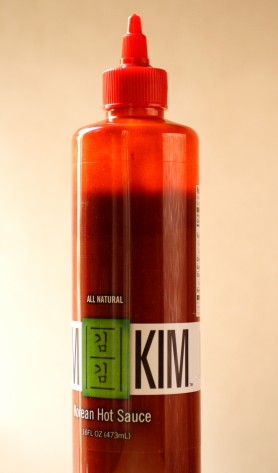
1. Get yourself a bottle of KimKim Sauce.
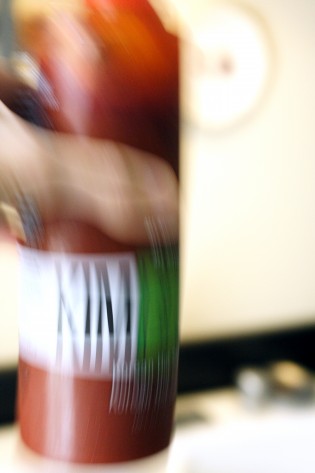
2. Shake it up.
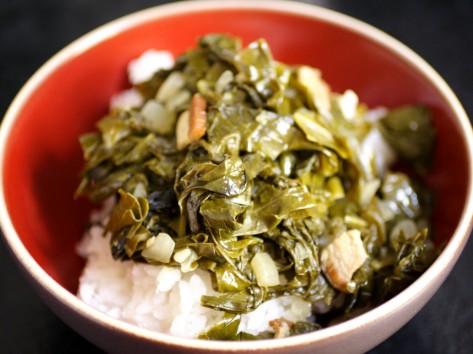
3. Have a bowl of your favorite food for KimKim Sauce at the ready; mine is greens over steamed short-grain rice.

4. Squeeze some KimKim Sauce on top.
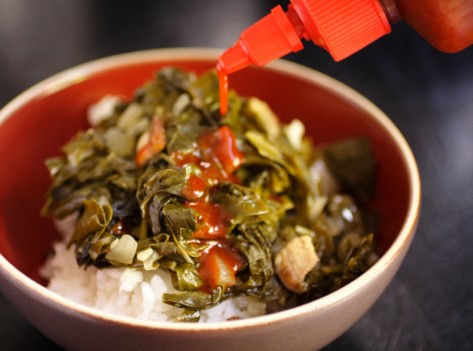
5. And some more.
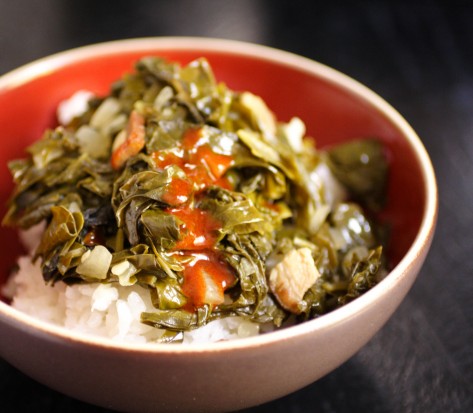
5. Et voilà.
Additional Information
That’s me, squirming on Santa’s lap and hoping for KimKim Sauce, and my sister, Heather, sitting on the floor and looking happy not to be on Santa’s lap. Puddles, my grandmother’s dog, can be seen peering out behind a bag of Christmas goodies.
I added the thought bubble using SuperLame, a free Flash-based speech bubble generator that allows you to add your own speech bubbles to photos.
